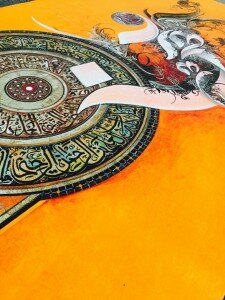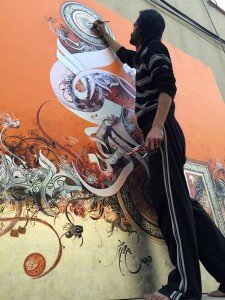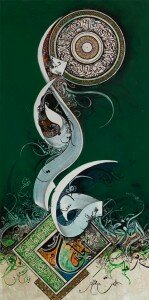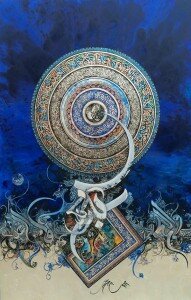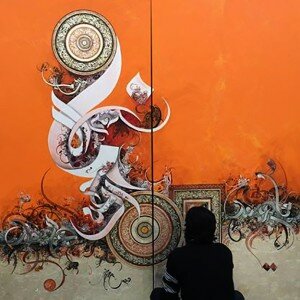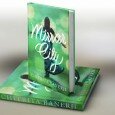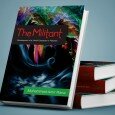By Qamar Riaz –
A Calligrapher Explains his Art
 A contemporary definition of calligraphic practice is ‘the art of giving a form to signs in an expressive, harmonious and skilful manner’. Creative calligraphy art portrays divine rhythmic beauty and exaltation in the spiritual domain. Calligraphy was a creative means to beautify buildings as distinctly Islamic as well as to pay tributes to the creator. In Muslim societies, almost every household was decorated with some kind of Islamic calligraphy, featuring different verses from the Holy Quran.
A contemporary definition of calligraphic practice is ‘the art of giving a form to signs in an expressive, harmonious and skilful manner’. Creative calligraphy art portrays divine rhythmic beauty and exaltation in the spiritual domain. Calligraphy was a creative means to beautify buildings as distinctly Islamic as well as to pay tributes to the creator. In Muslim societies, almost every household was decorated with some kind of Islamic calligraphy, featuring different verses from the Holy Quran.
In order not to let the centuries old tradition of Islamic calligraphy fade into oblivion, a designer by profession, young and frail Bin Qullander’s calligraphy paintings are a landmark in the genre of calligraphy and art in Pakistan. His rhythmic and logical works make a clear picture of design, colour sensibility and flow of line. They are musicals on the beat of the dervish as his name depicts his religious inclination which led him to peruse the holy Qura’an.
He sometimes creates this atmosphere with Diwani style, merging script with symbols, Iranian Khat-e-Shikesta and Khat-e-Diwani. Each canvas presents a scene of orchestra where every instrument plays its own role creating a symphony which touches the heart and soul of the audience. His works indicate hard work and gift of creativity bestowed upon him by the Almighty Creator. His designing ability and the holy script fuse into each other and the outcome is an aesthetic pleasure for the viewer.
Born in a family of Darvaish, nature chose a contrary path for Bin Qullander. He was born to perform the delicate work of art and design. Having the urge to do something which would live forever, his religious inclination led him to peruse the Holy Qura’an. It was from there that he received the light to find his path. His mystic message in colour shows his innovative mind. Delicate lines on canvases refer to his skill as a miniature painter. With selected and smooth hues Bin Qullander adds a note of perfection to his engaging canvases. Light backgrounds, middle tones and shadows enhance the soft lines making them readable and loud without disturbing the whole scenario.
What does “Bin Qullandar” means?
My father was a dervish in full attire. He used to wear ghunghroos (a band with bells), strings with beads and long, loose shirt with a thick baton in hand and danced at shrines on the beat of drums. I am like my father guised in different outfit. We are under the preaching of Silsila-e Qullanderi. My real name is Tahir Mahmood. My father asked me to include his name in his creative venture. As a result the viewer finds ‘Bin Qullander’ as a signature on my canvases.
At what age you became interested in Drawings/Calligraphy?
My early years were spent as a less expressive child with little attention on art. I was shy, obstinate, and, few and far between, aggressive in my nature. Whenever traveled, I used to think about the landscape; it became a major source of thrill and inspiration for me. At the age of ten, during a wedding ceremony in my village, I placed a piece of paper, a pencil and an eraser in my small pocket. I focused more on drawing the landscape than participating in the ceremony.
In 1996, when I was in the 9th grade, my elder brother got married. The photograph of his brother’s marriage appealed me to a great deal. I wished that I could paint the image of the bride and groom and give a pleasant surprise to my brother with an image capturing that magical moment.
How did you get into Calligraphy, did you study it professionally?
I started one year Diploma in Graphic Designing at Punjab University in 2003 while working at my part time job. Continuously applying for graduation, I was not glad in design class so I switched over to Fine Arts. After observing my abilities my teachers convinced me to take admission in National College of Arts. At fourth attempt, I got admission in NCA eventually by dint of my determined efforts and patience. During my studies I created calligraphic paintings and designs for which I received high acclamation and fame in Islamic design. I sold my first calligraphic paintings for Rs.25, 000.
When I was in the third year of miniature painting at National College of Arts, I exhibited my first solo show at Hamāìl Art Gallery. Pride of Performance, Professor Khurshid Alam Gohar Qalam from NCA encouraged me on the path of calligraphy while Mian Javed Iqbal was my mentor and persuader.
What was your dream assignment?
My fourth solo show was held in Dubai Art Gallery, which is another branch of Hamāìl Art Gallery Pakistan. In Dubai, one of my artistic paintings was purchased for Prime Minister’s Office at Emirates Tower in Dubai. Many non-Muslims also purchased my calligraphic paintings as master pieces. I have been to New York and went through many museums and art galleries to grab innovative thoughts for my future masterpieces. My group show has been held in Manhattan at 207 Gallery.
How do you see the future of calligraphy in Pakistan?
Calligraphy is an extremely demanding activity and most of the great Muslim masters had devoted their life to perfecting this art form. Unfortunately in Pakistan, we have done very little for the promotion of the art of calligraphy. In our society artists and art are placed either at a very high level or ignored as insignificant activities. Due to this attitude the artists have distanced themselves from the general public. In order to familiarize the new generation with the concept of calligraphy, my studio is always open for new learners. Studio BQ has displayed the work of participants of every workshops chaired by me to encourage the young and upcoming calligraphers.
![]() The writer is a freelance journalist and columnist. He tweets @qamerriaz
The writer is a freelance journalist and columnist. He tweets @qamerriaz























































































